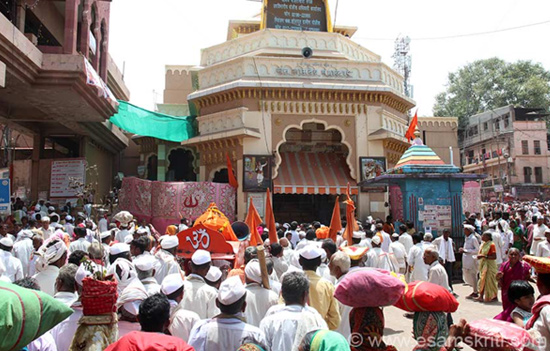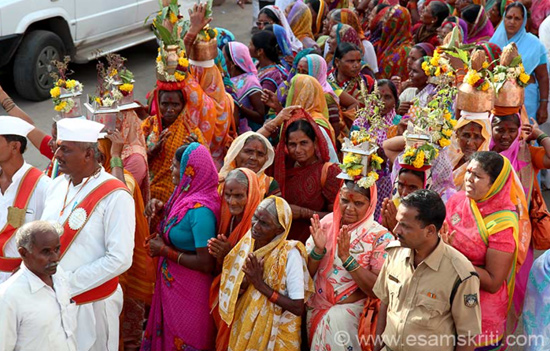- Know about the origins of the Varkari Movement, Sants associated with it and annual Varkari Yatra to Pandharpur.
Every year on the Ashada Ekadashi Day lakhs of pilgrims called Varkaris, walk to Pandharpur, in Sholapur district, to seek the blessings of Lord Vithoba (also called Vithal or Pandurang). The deity in Pandharpur stands on a brick (‘vit’ means brick and ‘thal’ means standing.) This tradition of annual pilgrimage Yatra, known as Dindi (procession), goes back to 13th century.
The
Varkari (means one who performs the vari/pilgrimage) movement was founded by
great Bhakti saints of Maharashtra, namely, Sant Dnyaneshwar, Tukaram and Eknath,
who belonged to different castes. They preached that love and devotion can be
followed by the common man. Devotional songs composed in the form of folk
music, like Abhang, Ovi, and Bharud, became the tools to spread faith at the
grass-root level across Maharashtra.
People
of all castes, in organised groups, start walking from different parts of
Maharashtra, often barefooted, to reach Pandharpur on Ashada Ekadashi day.
Palakhis (palanquin processions) carrying the paduka (footprints) of the deity
and various saints, especially, Sant Dnyaneshwar, and Sant Tukaram, from the
varkari sects are taken from the respective shrines to Pandharpur.
Sant Dnyaneshwar’s palakhi leaves from Alandi and that of Tukaram from Dehu, both in the Pune district. Many other palakhis join these two on their way to Pandharpur. The devotees wear Tulsi Mala and sing bhajans all the way. They take bath in the Chandrabhaga river, close to the temple, before visiting the shrine. The devotees from far and wide witness the Mahapuja performed on this holy day.
 Varkaris singing bhajans, kirtans enroute to Pandharpur. 2015.
Varkaris singing bhajans, kirtans enroute to Pandharpur. 2015.
The
Varkari movement includes the worship of Vithoba, recitation of chants on Hari
(Vishnu) every day, and regular practice of bhajans, good moral behaviour,
strict avoidance of alcohol and tobacco, adoption of a Sattvic diet, avoiding
onion and garlic and fasting on Ekadashi days, which come twice in a month. The
devotees should lead a simple life; practice forgiveness, peaceful
co-existence, compassion and non-violence; love all and treat all as equal,
irrespective of caste or religion.
It
is interesting to know the story of some saints who were closely associated
with the Vithoba temple. Sant Dnyaneshwar was a 13th century saint poet and
philosopher of the Nath Vaishnava tradition.
He wrote Dnyaneshwari, a commentary on Bhagavad Gita, and a book on his
spiritual experiences called Amruthanubhav.
Both these books are holy books of the varkaris. He was an ardent devotee of
Lord Vithoba of Pandharpur. His legacy inspired other saint poets such as
Eknath and Tukaram. He is regarded as one of the founders of the Varkari
movement.
First
published in Journal of Bharatiya Vidya Bhawan.
 Centre of pic is Sant Dynameshwar, right is Sant Tukaram. 2015.
Centre of pic is Sant Dynameshwar, right is Sant Tukaram. 2015.
Sant
Tukaram was a 17th century saint who promoted the Bhakti movement and the
Varkari devotional tradition. He is best known for his Abhangs, a form of devotional poetry, and community oriented
worship and singing of kirtans. He was a great devotee of Vithoba and his poems
were dedicated to Him.
His teachings can be summed up as the broad tenets of the
varkari sects-
1.
To worship and recognise divinity in every object and manifestations and not to
discriminate people on the basis of caste, gender or religion in the worship of
Lord Vithoba.
2.
To believe in unity of all Gods and basic beliefs of all religions.
3.
To practice nonviolence in thought, speech and action.
4.
To practice truthfulness and overcome passions and desires.
5.
To achieve tranquility of mind, be compassionate to all creatures and to
achieve a state of total detachment.
6.
To be humble in forgiveness and have internal and external purity.
7.
To avoid actions that are against the tenets of scriptures.
8.
To keep company of saints and those who love God.
9.
Spiritual life is fellowship with God through service, devotion and meditation.
10.
God tests His devotees by giving them troubles and hardships, but finally gives
them everlasting Bliss.
Sant
Eknath was a saint, philosopher and poet who lived in the 16th century. He was
a devotee of Lord Krishna and is an important figure in the Varkari tradition.
He is often viewed as a spiritual successor to Dnyaneshwar and Namdev.
Sant Namdev, a contemporary of Sant Dnyaneshwar, was a great devotee of Lord Vithoba. When he met Sant Dnyaneshwar he was attracted by the great devotee of Vithoba. The great saints never separated till death parted them. The temple’s first step is called ‘Namdev Chi Payari’ (step of Namdev).
 Temple of Vithoba, Pandharpur.
Temple of Vithoba, Pandharpur.
There is a legend behind this. As a child, the future saint Namdev, was an ardent devotee of Vithoba. One day, he offered ‘naivedya’ (sacred offering) to the Lord. He waited patiently for the Lord to appear and partake the offering. He kept on praying and requesting the Lord to appear in person and accept the offering. When the Lord did not appear, he was disheartened and started to bang his head on the steps. Seeing his sincere devotion, the Lord appeared and ate the offering and blessed Namdev. Namdev was delighted and asked the Lord to be present at the first step, when the devotees came to see Him. So this first step in the flight of steps is called ‘Namdev Chi Payari’.
 Some women carry Tusli plants on their head, other Kalash. Pandharpur Wari, 2015.
Some women carry Tusli plants on their head, other Kalash. Pandharpur Wari, 2015.
Ashada Ekadashi (June –July), which falls on the brighter fortnight (Shukla Paksha) is also known as Harishyana/Devashayana/Padma Ekadashi. It is the day Lord Vishnu goes to sleep on the Shesh Nag for four months until Uddana/Haribodhini Ekadashi, which also falls in the brighter fortnight in Kartik (November-December) month. These two Ekadashis are considered sacred and some devotees observe vari (pilgrimage) and worship Vithoba on both these days. Uddana Ekadashi is also known as Guruvayoor Ekadashi.
This year Ashada Ekadashi is on July 20, 2021 and Uddana Ekadashi on December
14, 2021.
It
is believed that participation in the pilgrimage to Pandharpur brings good
health, peace and prosperity to the devotees. Chanting the glory of the Lord
cleanses the body, mind and spirit. The pilgrims who visit Lord Vithoba on
Ashada Ekadashi Day experience divine bliss.
This article was first published in the Bhavan’s Journal, 31 July 2021 issue. This article is courtesy and copyright Bhavan’s Journal, Bharatiya Vidya Bhavan, Mumbai-400007. eSamskriti has obtained permission from Bhavan’s Journal to share. Do subscribe to the Bhavan’s Journal – it is very good.
Also read
1. Album
Pandarpur WARI
2. EKANATH,
the Reformer
3. Vithoba
of Pandharpur